Analysis of Financial Statements for Fraudulent Activities
VerifiedAdded on 2020/05/11
|19
|3492
|49
AI Summary
In this case study, students are tasked with analyzing financial data from three consecutive years to uncover any irregularities or signs of fraudulent activities within a company's financial reporting. The assignment requires examining changes in cash flow, receivables, inventories, liabilities, and equity positions over the period. Students will leverage insights from references such as forensic accounting techniques discussed by Bamberger et al., 'Forensic Accounting Investigation: A Practitioner’s Guide,' to apply theoretical knowledge practically. The goal is to develop a comprehensive understanding of financial anomalies that could indicate fraud, such as unusual fluctuations in asset valuations or liabilities and inconsistencies in reported earnings compared to cash flows. By cross-referencing the provided data with forensic accounting practices, students will prepare a detailed report highlighting their findings and suggesting potential areas for further investigation.
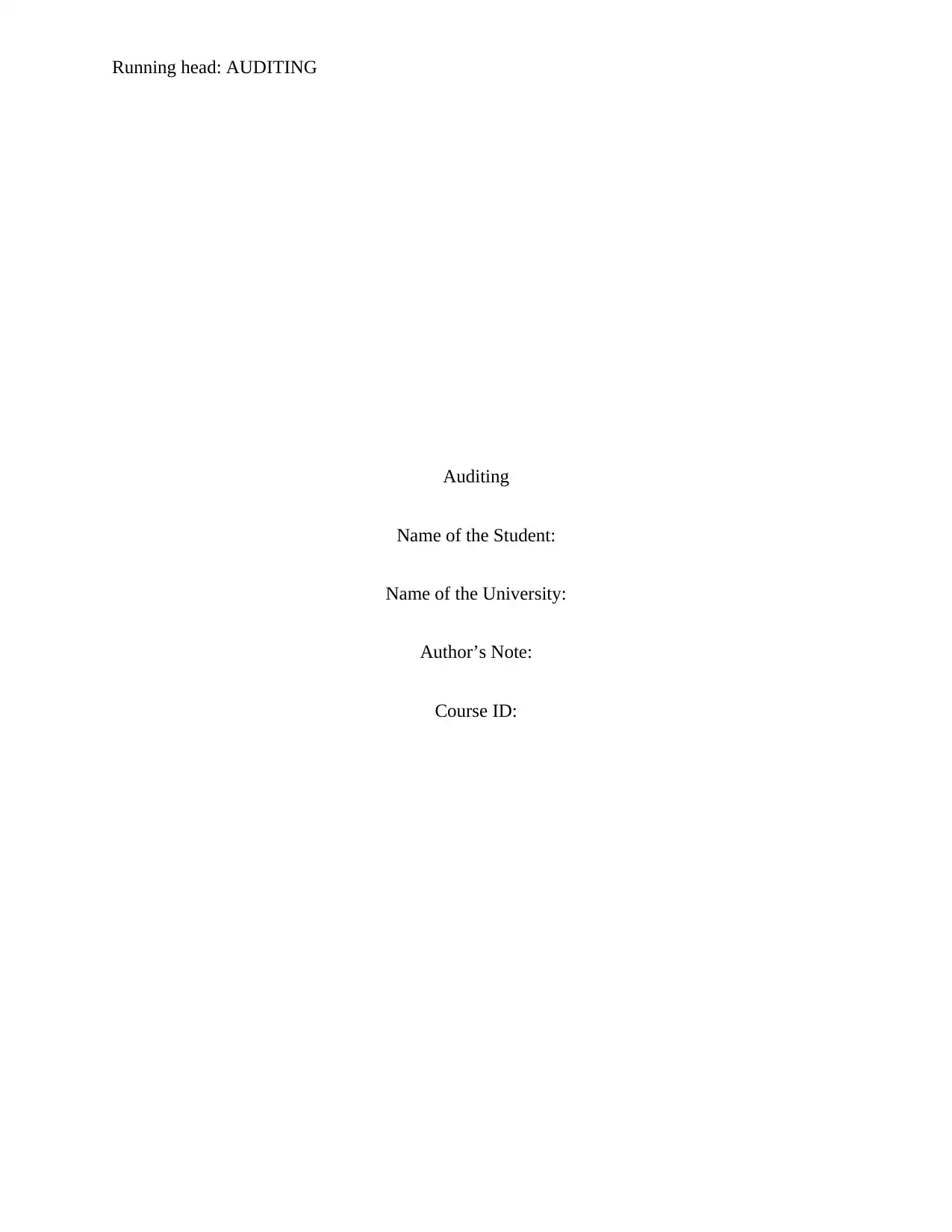
Running head: AUDITING
Auditing
Name of the Student:
Name of the University:
Author’s Note:
Course ID:
Auditing
Name of the Student:
Name of the University:
Author’s Note:
Course ID:
Paraphrase This Document
Need a fresh take? Get an instant paraphrase of this document with our AI Paraphraser
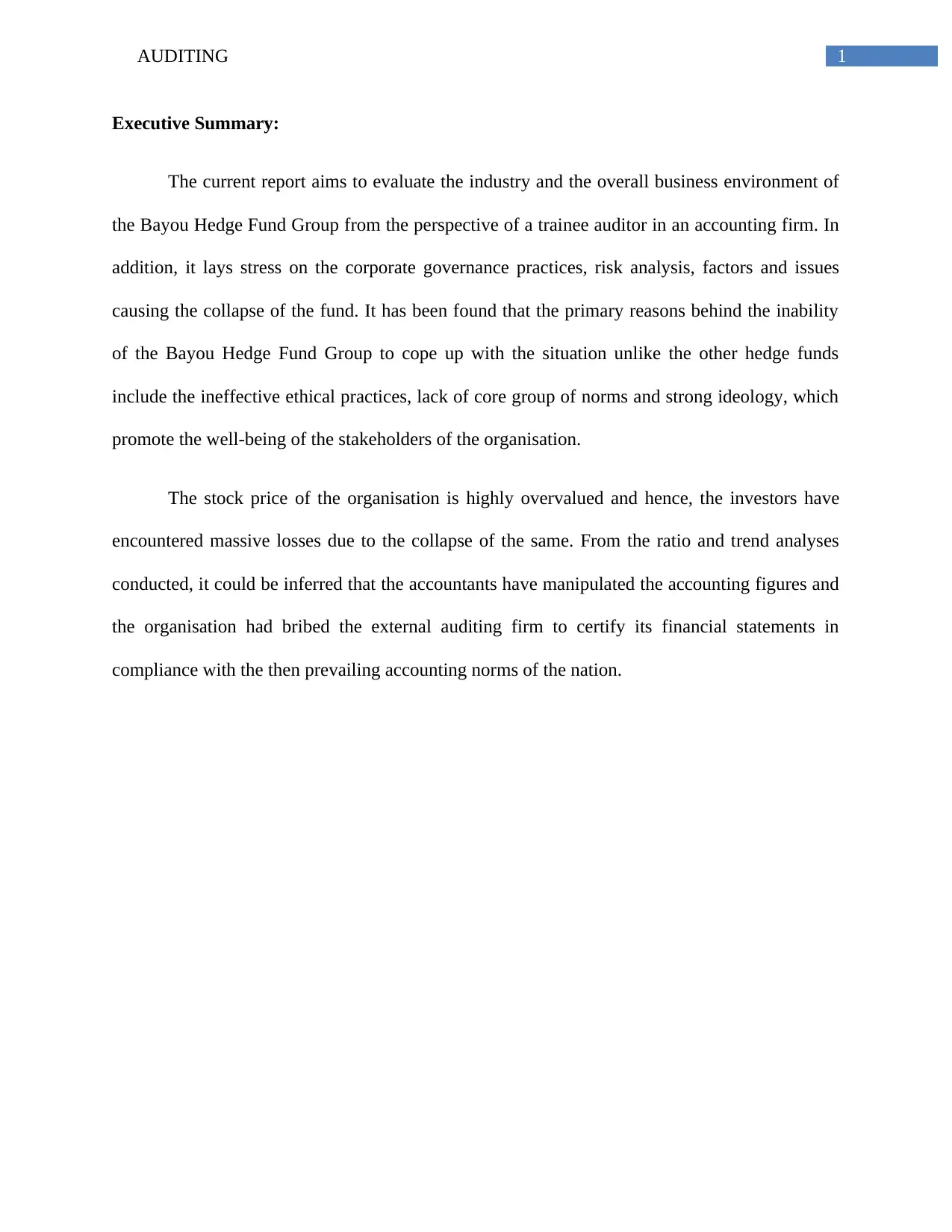
1AUDITING
Executive Summary:
The current report aims to evaluate the industry and the overall business environment of
the Bayou Hedge Fund Group from the perspective of a trainee auditor in an accounting firm. In
addition, it lays stress on the corporate governance practices, risk analysis, factors and issues
causing the collapse of the fund. It has been found that the primary reasons behind the inability
of the Bayou Hedge Fund Group to cope up with the situation unlike the other hedge funds
include the ineffective ethical practices, lack of core group of norms and strong ideology, which
promote the well-being of the stakeholders of the organisation.
The stock price of the organisation is highly overvalued and hence, the investors have
encountered massive losses due to the collapse of the same. From the ratio and trend analyses
conducted, it could be inferred that the accountants have manipulated the accounting figures and
the organisation had bribed the external auditing firm to certify its financial statements in
compliance with the then prevailing accounting norms of the nation.
Executive Summary:
The current report aims to evaluate the industry and the overall business environment of
the Bayou Hedge Fund Group from the perspective of a trainee auditor in an accounting firm. In
addition, it lays stress on the corporate governance practices, risk analysis, factors and issues
causing the collapse of the fund. It has been found that the primary reasons behind the inability
of the Bayou Hedge Fund Group to cope up with the situation unlike the other hedge funds
include the ineffective ethical practices, lack of core group of norms and strong ideology, which
promote the well-being of the stakeholders of the organisation.
The stock price of the organisation is highly overvalued and hence, the investors have
encountered massive losses due to the collapse of the same. From the ratio and trend analyses
conducted, it could be inferred that the accountants have manipulated the accounting figures and
the organisation had bribed the external auditing firm to certify its financial statements in
compliance with the then prevailing accounting norms of the nation.

2AUDITING
Table of Contents
1. Introduction:................................................................................................................................3
2. Industry and business environment:............................................................................................3
3. Corporate governance:.................................................................................................................4
4. Risk analysis:...............................................................................................................................5
5. Factors of collapse:......................................................................................................................6
6. Ratio, trend analysis or analytical procedures:............................................................................8
7. Conclusion:................................................................................................................................13
References:....................................................................................................................................15
Appendices:...................................................................................................................................17
Table of Contents
1. Introduction:................................................................................................................................3
2. Industry and business environment:............................................................................................3
3. Corporate governance:.................................................................................................................4
4. Risk analysis:...............................................................................................................................5
5. Factors of collapse:......................................................................................................................6
6. Ratio, trend analysis or analytical procedures:............................................................................8
7. Conclusion:................................................................................................................................13
References:....................................................................................................................................15
Appendices:...................................................................................................................................17
⊘ This is a preview!⊘
Do you want full access?
Subscribe today to unlock all pages.

Trusted by 1+ million students worldwide
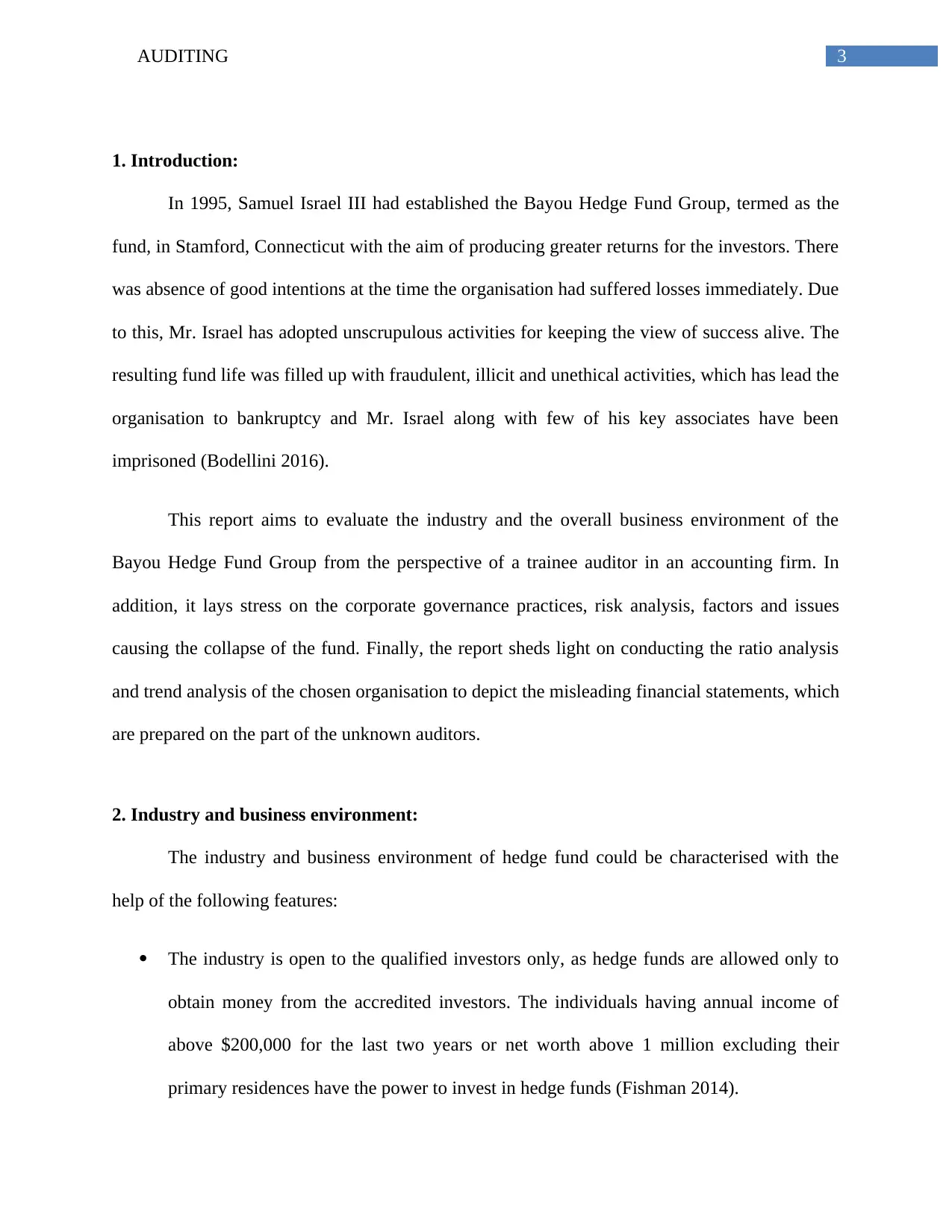
3AUDITING
1. Introduction:
In 1995, Samuel Israel III had established the Bayou Hedge Fund Group, termed as the
fund, in Stamford, Connecticut with the aim of producing greater returns for the investors. There
was absence of good intentions at the time the organisation had suffered losses immediately. Due
to this, Mr. Israel has adopted unscrupulous activities for keeping the view of success alive. The
resulting fund life was filled up with fraudulent, illicit and unethical activities, which has lead the
organisation to bankruptcy and Mr. Israel along with few of his key associates have been
imprisoned (Bodellini 2016).
This report aims to evaluate the industry and the overall business environment of the
Bayou Hedge Fund Group from the perspective of a trainee auditor in an accounting firm. In
addition, it lays stress on the corporate governance practices, risk analysis, factors and issues
causing the collapse of the fund. Finally, the report sheds light on conducting the ratio analysis
and trend analysis of the chosen organisation to depict the misleading financial statements, which
are prepared on the part of the unknown auditors.
2. Industry and business environment:
The industry and business environment of hedge fund could be characterised with the
help of the following features:
The industry is open to the qualified investors only, as hedge funds are allowed only to
obtain money from the accredited investors. The individuals having annual income of
above $200,000 for the last two years or net worth above 1 million excluding their
primary residences have the power to invest in hedge funds (Fishman 2014).
1. Introduction:
In 1995, Samuel Israel III had established the Bayou Hedge Fund Group, termed as the
fund, in Stamford, Connecticut with the aim of producing greater returns for the investors. There
was absence of good intentions at the time the organisation had suffered losses immediately. Due
to this, Mr. Israel has adopted unscrupulous activities for keeping the view of success alive. The
resulting fund life was filled up with fraudulent, illicit and unethical activities, which has lead the
organisation to bankruptcy and Mr. Israel along with few of his key associates have been
imprisoned (Bodellini 2016).
This report aims to evaluate the industry and the overall business environment of the
Bayou Hedge Fund Group from the perspective of a trainee auditor in an accounting firm. In
addition, it lays stress on the corporate governance practices, risk analysis, factors and issues
causing the collapse of the fund. Finally, the report sheds light on conducting the ratio analysis
and trend analysis of the chosen organisation to depict the misleading financial statements, which
are prepared on the part of the unknown auditors.
2. Industry and business environment:
The industry and business environment of hedge fund could be characterised with the
help of the following features:
The industry is open to the qualified investors only, as hedge funds are allowed only to
obtain money from the accredited investors. The individuals having annual income of
above $200,000 for the last two years or net worth above 1 million excluding their
primary residences have the power to invest in hedge funds (Fishman 2014).
Paraphrase This Document
Need a fresh take? Get an instant paraphrase of this document with our AI Paraphraser
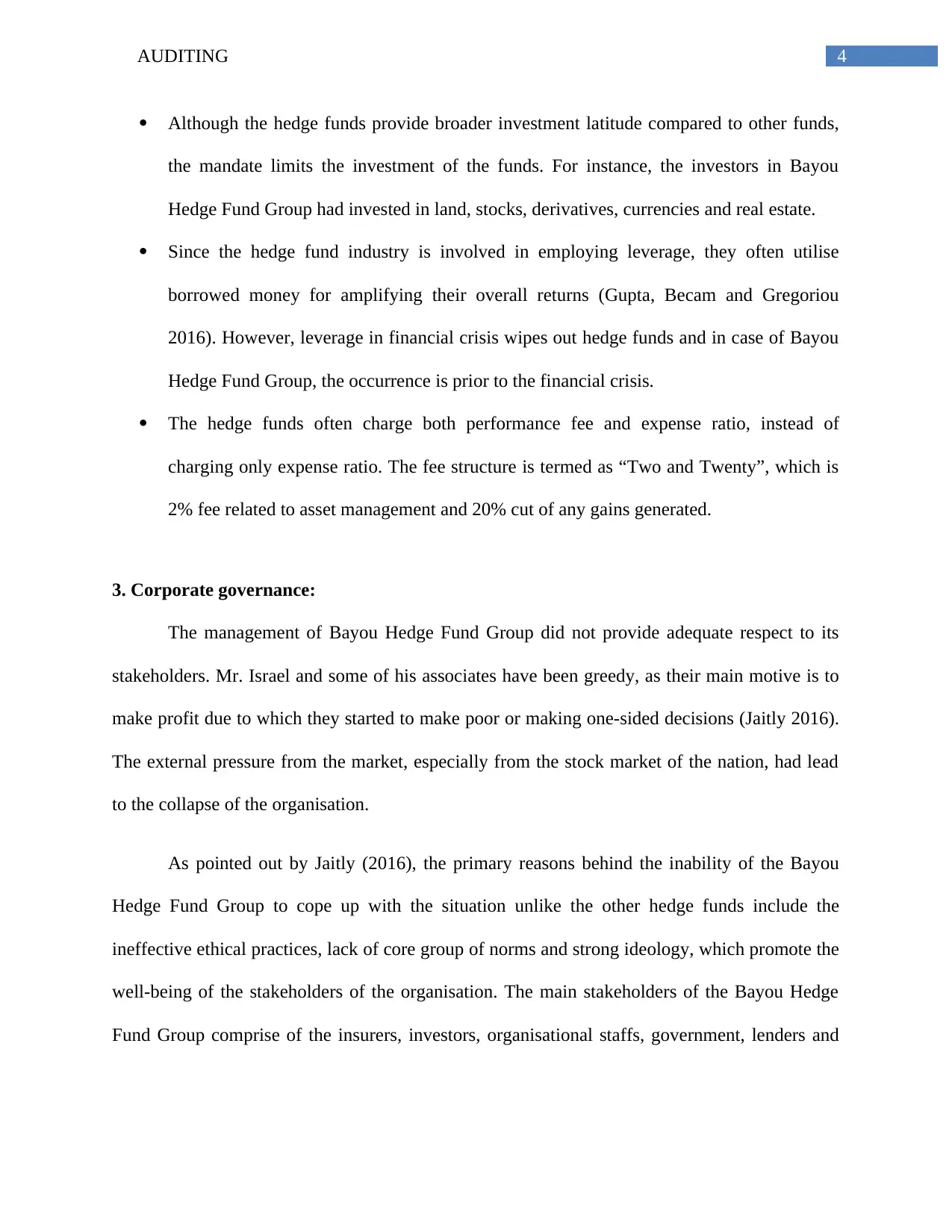
4AUDITING
Although the hedge funds provide broader investment latitude compared to other funds,
the mandate limits the investment of the funds. For instance, the investors in Bayou
Hedge Fund Group had invested in land, stocks, derivatives, currencies and real estate.
Since the hedge fund industry is involved in employing leverage, they often utilise
borrowed money for amplifying their overall returns (Gupta, Becam and Gregoriou
2016). However, leverage in financial crisis wipes out hedge funds and in case of Bayou
Hedge Fund Group, the occurrence is prior to the financial crisis.
The hedge funds often charge both performance fee and expense ratio, instead of
charging only expense ratio. The fee structure is termed as “Two and Twenty”, which is
2% fee related to asset management and 20% cut of any gains generated.
3. Corporate governance:
The management of Bayou Hedge Fund Group did not provide adequate respect to its
stakeholders. Mr. Israel and some of his associates have been greedy, as their main motive is to
make profit due to which they started to make poor or making one-sided decisions (Jaitly 2016).
The external pressure from the market, especially from the stock market of the nation, had lead
to the collapse of the organisation.
As pointed out by Jaitly (2016), the primary reasons behind the inability of the Bayou
Hedge Fund Group to cope up with the situation unlike the other hedge funds include the
ineffective ethical practices, lack of core group of norms and strong ideology, which promote the
well-being of the stakeholders of the organisation. The main stakeholders of the Bayou Hedge
Fund Group comprise of the insurers, investors, organisational staffs, government, lenders and
Although the hedge funds provide broader investment latitude compared to other funds,
the mandate limits the investment of the funds. For instance, the investors in Bayou
Hedge Fund Group had invested in land, stocks, derivatives, currencies and real estate.
Since the hedge fund industry is involved in employing leverage, they often utilise
borrowed money for amplifying their overall returns (Gupta, Becam and Gregoriou
2016). However, leverage in financial crisis wipes out hedge funds and in case of Bayou
Hedge Fund Group, the occurrence is prior to the financial crisis.
The hedge funds often charge both performance fee and expense ratio, instead of
charging only expense ratio. The fee structure is termed as “Two and Twenty”, which is
2% fee related to asset management and 20% cut of any gains generated.
3. Corporate governance:
The management of Bayou Hedge Fund Group did not provide adequate respect to its
stakeholders. Mr. Israel and some of his associates have been greedy, as their main motive is to
make profit due to which they started to make poor or making one-sided decisions (Jaitly 2016).
The external pressure from the market, especially from the stock market of the nation, had lead
to the collapse of the organisation.
As pointed out by Jaitly (2016), the primary reasons behind the inability of the Bayou
Hedge Fund Group to cope up with the situation unlike the other hedge funds include the
ineffective ethical practices, lack of core group of norms and strong ideology, which promote the
well-being of the stakeholders of the organisation. The main stakeholders of the Bayou Hedge
Fund Group comprise of the insurers, investors, organisational staffs, government, lenders and

5AUDITING
borrowers and these groups have been influenced adversely due to the unethical decisions made
on the part of the management.
In the words of Jorion and Schwarz (2014), the corporate governance of the Bayou
Hedge Fund Group could be considered as deontology, since in a business decision, it is not
possible for anyone to remain aware of the consequences in the beginning years. However, the
organisation could have adopted set of ethical policies and norms that it could follow in the
beginning years. These ethical norms would take care of the decisions automatically, since such
rules could not control the consequences of such decisions. Hence, Bayou Hedge Fund Group or
its executives could have undertaken ethical decisions from the initial stage that could have
saved the organisation from bankruptcy (Kaal 2013).
In addition, the board of directors of the Bayou Hedge Fund Group could have
concentrated on making ethical decisions and ethical theory decades ago. If such practice had
been adopted, it could have helped in protecting and navigating the fund from such illegal
activities (Pascalau 2014). However, the organisation has failed to manage the situation due to
the market deficiencies and greed had besieged the top executives.
4. Risk analysis:
The risk analysis of the Bayou Hedge Fund Group could be represented as follows:
Standard deviation:
It is the most common measure of risk used in hedge funds and it ascertains the volatility
level of returns expressed in percentage terms (Ang 2017). However, in case of the Bayou Hedge
borrowers and these groups have been influenced adversely due to the unethical decisions made
on the part of the management.
In the words of Jorion and Schwarz (2014), the corporate governance of the Bayou
Hedge Fund Group could be considered as deontology, since in a business decision, it is not
possible for anyone to remain aware of the consequences in the beginning years. However, the
organisation could have adopted set of ethical policies and norms that it could follow in the
beginning years. These ethical norms would take care of the decisions automatically, since such
rules could not control the consequences of such decisions. Hence, Bayou Hedge Fund Group or
its executives could have undertaken ethical decisions from the initial stage that could have
saved the organisation from bankruptcy (Kaal 2013).
In addition, the board of directors of the Bayou Hedge Fund Group could have
concentrated on making ethical decisions and ethical theory decades ago. If such practice had
been adopted, it could have helped in protecting and navigating the fund from such illegal
activities (Pascalau 2014). However, the organisation has failed to manage the situation due to
the market deficiencies and greed had besieged the top executives.
4. Risk analysis:
The risk analysis of the Bayou Hedge Fund Group could be represented as follows:
Standard deviation:
It is the most common measure of risk used in hedge funds and it ascertains the volatility
level of returns expressed in percentage terms (Ang 2017). However, in case of the Bayou Hedge
⊘ This is a preview!⊘
Do you want full access?
Subscribe today to unlock all pages.

Trusted by 1+ million students worldwide
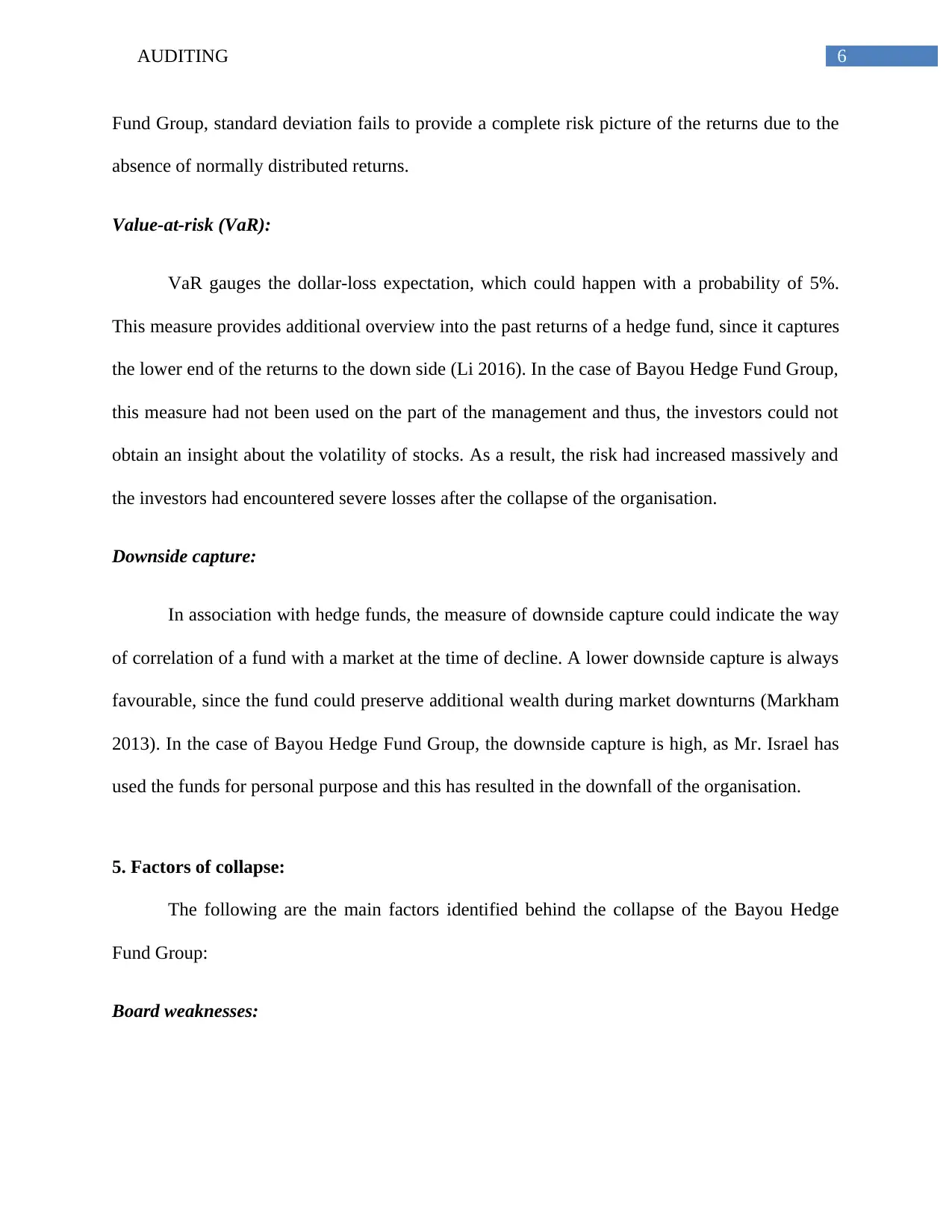
6AUDITING
Fund Group, standard deviation fails to provide a complete risk picture of the returns due to the
absence of normally distributed returns.
Value-at-risk (VaR):
VaR gauges the dollar-loss expectation, which could happen with a probability of 5%.
This measure provides additional overview into the past returns of a hedge fund, since it captures
the lower end of the returns to the down side (Li 2016). In the case of Bayou Hedge Fund Group,
this measure had not been used on the part of the management and thus, the investors could not
obtain an insight about the volatility of stocks. As a result, the risk had increased massively and
the investors had encountered severe losses after the collapse of the organisation.
Downside capture:
In association with hedge funds, the measure of downside capture could indicate the way
of correlation of a fund with a market at the time of decline. A lower downside capture is always
favourable, since the fund could preserve additional wealth during market downturns (Markham
2013). In the case of Bayou Hedge Fund Group, the downside capture is high, as Mr. Israel has
used the funds for personal purpose and this has resulted in the downfall of the organisation.
5. Factors of collapse:
The following are the main factors identified behind the collapse of the Bayou Hedge
Fund Group:
Board weaknesses:
Fund Group, standard deviation fails to provide a complete risk picture of the returns due to the
absence of normally distributed returns.
Value-at-risk (VaR):
VaR gauges the dollar-loss expectation, which could happen with a probability of 5%.
This measure provides additional overview into the past returns of a hedge fund, since it captures
the lower end of the returns to the down side (Li 2016). In the case of Bayou Hedge Fund Group,
this measure had not been used on the part of the management and thus, the investors could not
obtain an insight about the volatility of stocks. As a result, the risk had increased massively and
the investors had encountered severe losses after the collapse of the organisation.
Downside capture:
In association with hedge funds, the measure of downside capture could indicate the way
of correlation of a fund with a market at the time of decline. A lower downside capture is always
favourable, since the fund could preserve additional wealth during market downturns (Markham
2013). In the case of Bayou Hedge Fund Group, the downside capture is high, as Mr. Israel has
used the funds for personal purpose and this has resulted in the downfall of the organisation.
5. Factors of collapse:
The following are the main factors identified behind the collapse of the Bayou Hedge
Fund Group:
Board weaknesses:
Paraphrase This Document
Need a fresh take? Get an instant paraphrase of this document with our AI Paraphraser
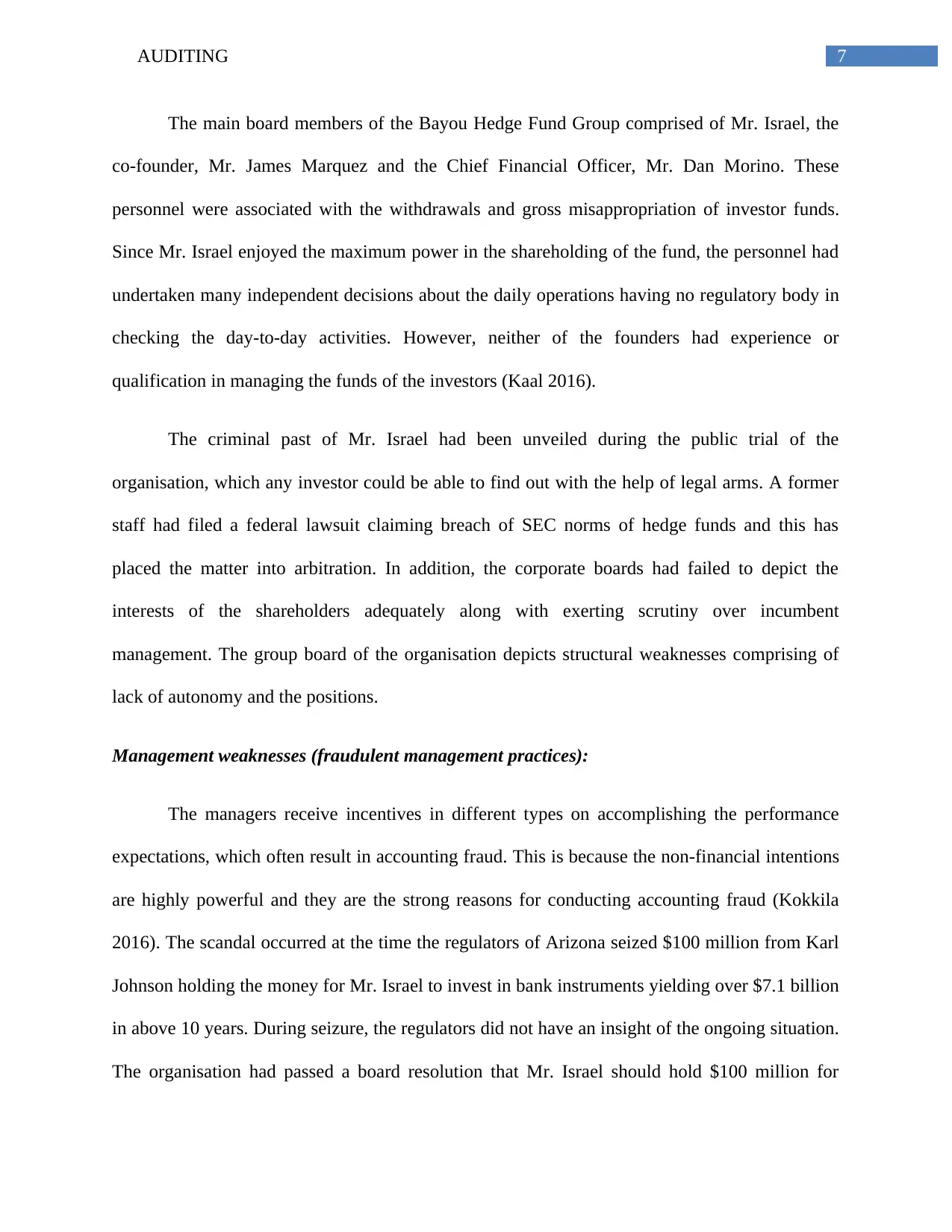
7AUDITING
The main board members of the Bayou Hedge Fund Group comprised of Mr. Israel, the
co-founder, Mr. James Marquez and the Chief Financial Officer, Mr. Dan Morino. These
personnel were associated with the withdrawals and gross misappropriation of investor funds.
Since Mr. Israel enjoyed the maximum power in the shareholding of the fund, the personnel had
undertaken many independent decisions about the daily operations having no regulatory body in
checking the day-to-day activities. However, neither of the founders had experience or
qualification in managing the funds of the investors (Kaal 2016).
The criminal past of Mr. Israel had been unveiled during the public trial of the
organisation, which any investor could be able to find out with the help of legal arms. A former
staff had filed a federal lawsuit claiming breach of SEC norms of hedge funds and this has
placed the matter into arbitration. In addition, the corporate boards had failed to depict the
interests of the shareholders adequately along with exerting scrutiny over incumbent
management. The group board of the organisation depicts structural weaknesses comprising of
lack of autonomy and the positions.
Management weaknesses (fraudulent management practices):
The managers receive incentives in different types on accomplishing the performance
expectations, which often result in accounting fraud. This is because the non-financial intentions
are highly powerful and they are the strong reasons for conducting accounting fraud (Kokkila
2016). The scandal occurred at the time the regulators of Arizona seized $100 million from Karl
Johnson holding the money for Mr. Israel to invest in bank instruments yielding over $7.1 billion
in above 10 years. During seizure, the regulators did not have an insight of the ongoing situation.
The organisation had passed a board resolution that Mr. Israel should hold $100 million for
The main board members of the Bayou Hedge Fund Group comprised of Mr. Israel, the
co-founder, Mr. James Marquez and the Chief Financial Officer, Mr. Dan Morino. These
personnel were associated with the withdrawals and gross misappropriation of investor funds.
Since Mr. Israel enjoyed the maximum power in the shareholding of the fund, the personnel had
undertaken many independent decisions about the daily operations having no regulatory body in
checking the day-to-day activities. However, neither of the founders had experience or
qualification in managing the funds of the investors (Kaal 2016).
The criminal past of Mr. Israel had been unveiled during the public trial of the
organisation, which any investor could be able to find out with the help of legal arms. A former
staff had filed a federal lawsuit claiming breach of SEC norms of hedge funds and this has
placed the matter into arbitration. In addition, the corporate boards had failed to depict the
interests of the shareholders adequately along with exerting scrutiny over incumbent
management. The group board of the organisation depicts structural weaknesses comprising of
lack of autonomy and the positions.
Management weaknesses (fraudulent management practices):
The managers receive incentives in different types on accomplishing the performance
expectations, which often result in accounting fraud. This is because the non-financial intentions
are highly powerful and they are the strong reasons for conducting accounting fraud (Kokkila
2016). The scandal occurred at the time the regulators of Arizona seized $100 million from Karl
Johnson holding the money for Mr. Israel to invest in bank instruments yielding over $7.1 billion
in above 10 years. During seizure, the regulators did not have an insight of the ongoing situation.
The organisation had passed a board resolution that Mr. Israel should hold $100 million for

8AUDITING
offshore investments. The personnel had been involved in sending mails daily to the investors
along with informing them about the closure of the fund operations to devote time for family and
that the investors would receive funds in mid-August. This was the last communication made to
the clients and after that; the investors had not obtained their funds.
6. Ratio, trend analysis or analytical procedures:
The following ratios have been considered to evaluate the reasons behind the collapse of
the Bayou Hedge Fund Group:
Profitability ratios:
Particulars Details 2004 2005
Revenue A
1,16,19
9
1,18,71
9
Net income B
2,37
7
2,35
0
Operating
income C
3,62
4
3,67
2
Total assets D
33,44
0
33,16
3
Total current
liabilities E
16,54
0
15,57
5
Net margin B/A 2.05% 1.98%
Return on
capital
C/(D-E) 21.44% 20.88%
offshore investments. The personnel had been involved in sending mails daily to the investors
along with informing them about the closure of the fund operations to devote time for family and
that the investors would receive funds in mid-August. This was the last communication made to
the clients and after that; the investors had not obtained their funds.
6. Ratio, trend analysis or analytical procedures:
The following ratios have been considered to evaluate the reasons behind the collapse of
the Bayou Hedge Fund Group:
Profitability ratios:
Particulars Details 2004 2005
Revenue A
1,16,19
9
1,18,71
9
Net income B
2,37
7
2,35
0
Operating
income C
3,62
4
3,67
2
Total assets D
33,44
0
33,16
3
Total current
liabilities E
16,54
0
15,57
5
Net margin B/A 2.05% 1.98%
Return on
capital
C/(D-E) 21.44% 20.88%
⊘ This is a preview!⊘
Do you want full access?
Subscribe today to unlock all pages.

Trusted by 1+ million students worldwide
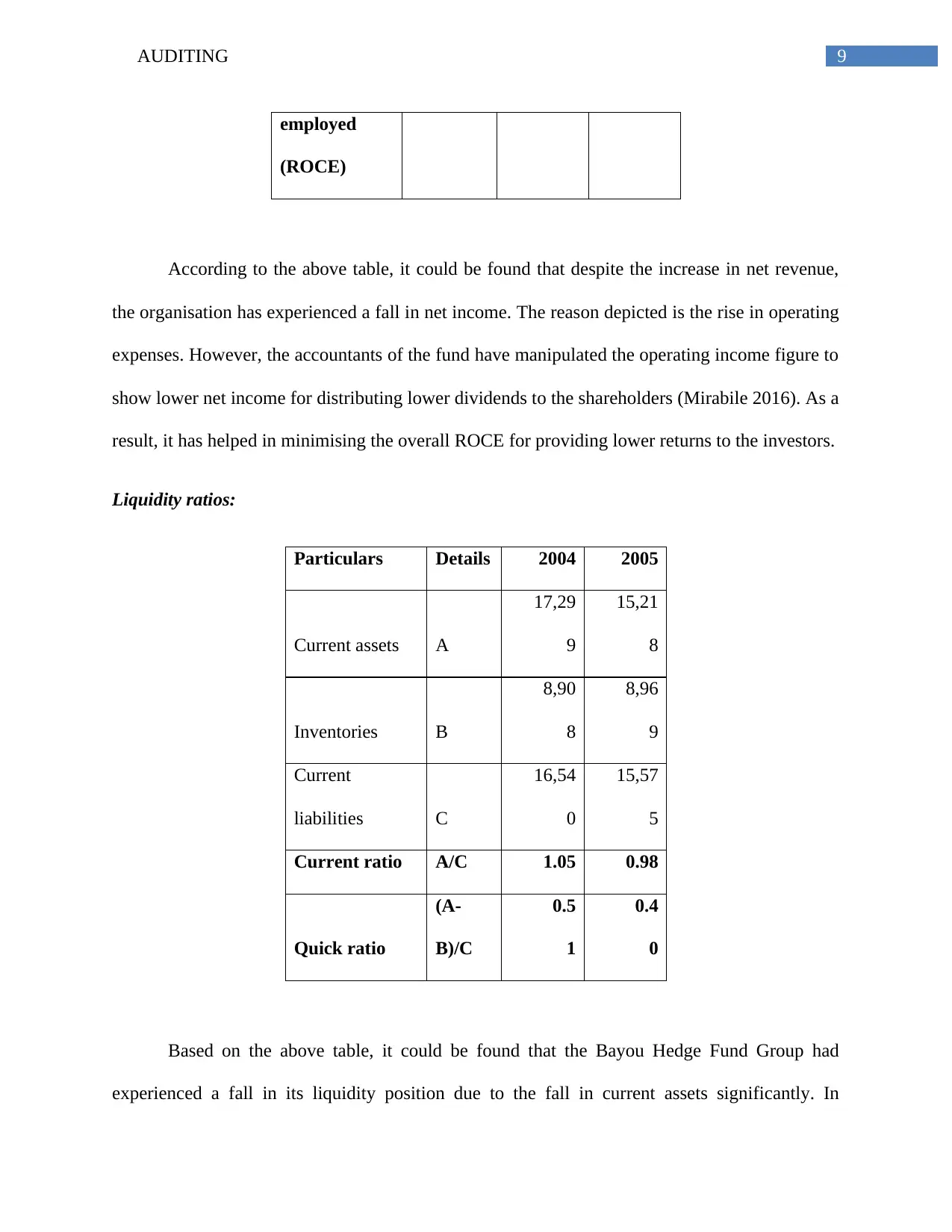
9AUDITING
employed
(ROCE)
According to the above table, it could be found that despite the increase in net revenue,
the organisation has experienced a fall in net income. The reason depicted is the rise in operating
expenses. However, the accountants of the fund have manipulated the operating income figure to
show lower net income for distributing lower dividends to the shareholders (Mirabile 2016). As a
result, it has helped in minimising the overall ROCE for providing lower returns to the investors.
Liquidity ratios:
Particulars Details 2004 2005
Current assets A
17,29
9
15,21
8
Inventories B
8,90
8
8,96
9
Current
liabilities C
16,54
0
15,57
5
Current ratio A/C 1.05 0.98
Quick ratio
(A-
B)/C
0.5
1
0.4
0
Based on the above table, it could be found that the Bayou Hedge Fund Group had
experienced a fall in its liquidity position due to the fall in current assets significantly. In
employed
(ROCE)
According to the above table, it could be found that despite the increase in net revenue,
the organisation has experienced a fall in net income. The reason depicted is the rise in operating
expenses. However, the accountants of the fund have manipulated the operating income figure to
show lower net income for distributing lower dividends to the shareholders (Mirabile 2016). As a
result, it has helped in minimising the overall ROCE for providing lower returns to the investors.
Liquidity ratios:
Particulars Details 2004 2005
Current assets A
17,29
9
15,21
8
Inventories B
8,90
8
8,96
9
Current
liabilities C
16,54
0
15,57
5
Current ratio A/C 1.05 0.98
Quick ratio
(A-
B)/C
0.5
1
0.4
0
Based on the above table, it could be found that the Bayou Hedge Fund Group had
experienced a fall in its liquidity position due to the fall in current assets significantly. In
Paraphrase This Document
Need a fresh take? Get an instant paraphrase of this document with our AI Paraphraser
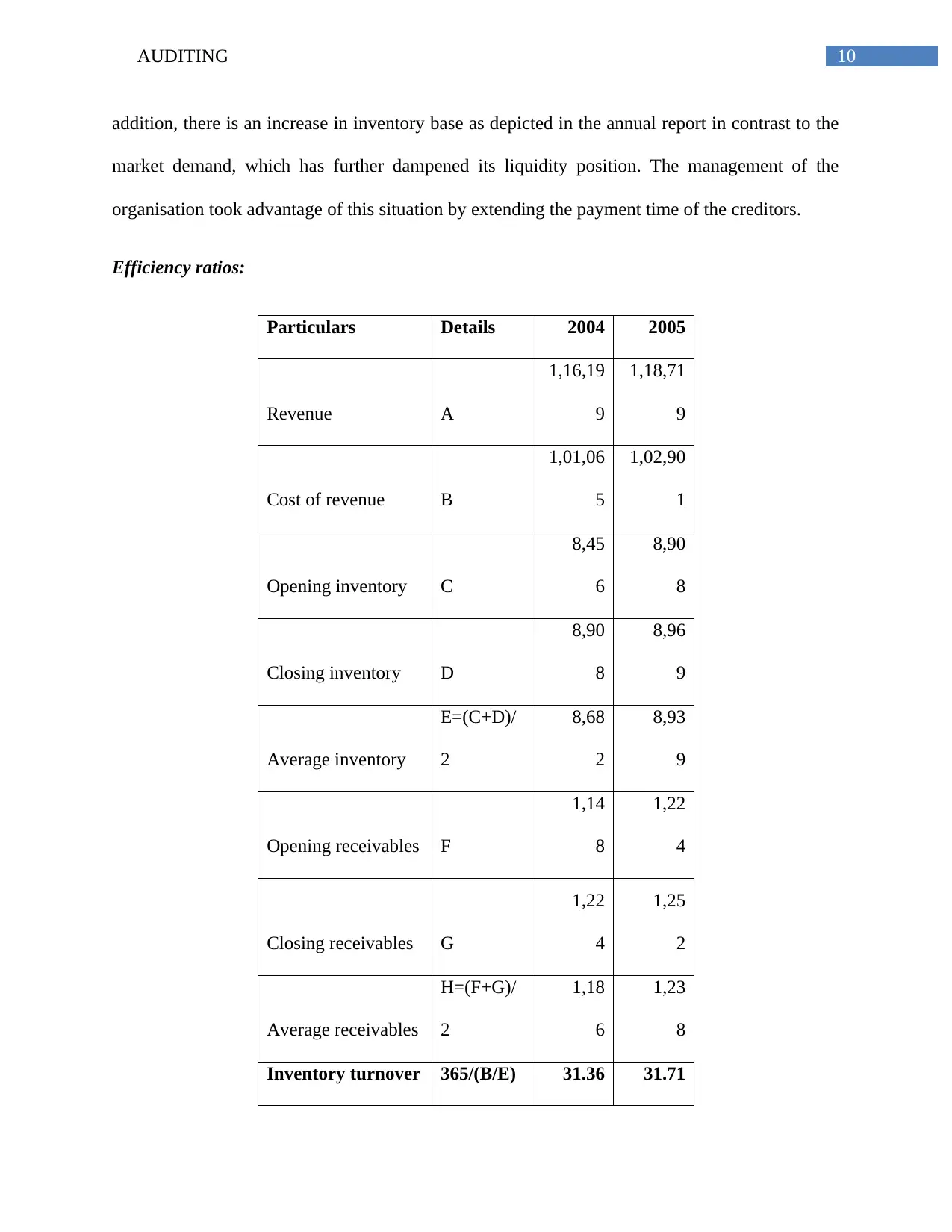
10AUDITING
addition, there is an increase in inventory base as depicted in the annual report in contrast to the
market demand, which has further dampened its liquidity position. The management of the
organisation took advantage of this situation by extending the payment time of the creditors.
Efficiency ratios:
Particulars Details 2004 2005
Revenue A
1,16,19
9
1,18,71
9
Cost of revenue B
1,01,06
5
1,02,90
1
Opening inventory C
8,45
6
8,90
8
Closing inventory D
8,90
8
8,96
9
Average inventory
E=(C+D)/
2
8,68
2
8,93
9
Opening receivables F
1,14
8
1,22
4
Closing receivables G
1,22
4
1,25
2
Average receivables
H=(F+G)/
2
1,18
6
1,23
8
Inventory turnover 365/(B/E) 31.36 31.71
addition, there is an increase in inventory base as depicted in the annual report in contrast to the
market demand, which has further dampened its liquidity position. The management of the
organisation took advantage of this situation by extending the payment time of the creditors.
Efficiency ratios:
Particulars Details 2004 2005
Revenue A
1,16,19
9
1,18,71
9
Cost of revenue B
1,01,06
5
1,02,90
1
Opening inventory C
8,45
6
8,90
8
Closing inventory D
8,90
8
8,96
9
Average inventory
E=(C+D)/
2
8,68
2
8,93
9
Opening receivables F
1,14
8
1,22
4
Closing receivables G
1,22
4
1,25
2
Average receivables
H=(F+G)/
2
1,18
6
1,23
8
Inventory turnover 365/(B/E) 31.36 31.71
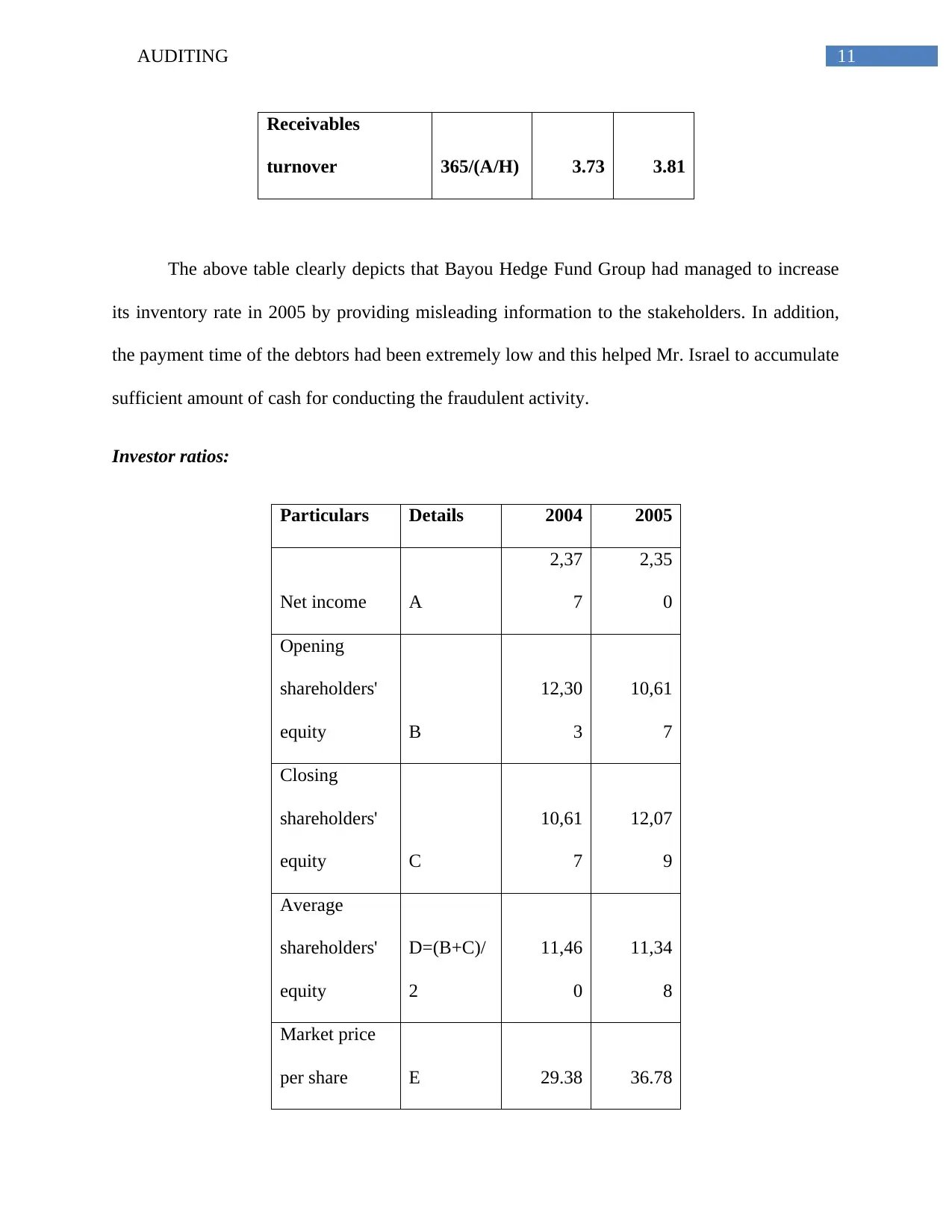
11AUDITING
Receivables
turnover 365/(A/H) 3.73 3.81
The above table clearly depicts that Bayou Hedge Fund Group had managed to increase
its inventory rate in 2005 by providing misleading information to the stakeholders. In addition,
the payment time of the debtors had been extremely low and this helped Mr. Israel to accumulate
sufficient amount of cash for conducting the fraudulent activity.
Investor ratios:
Particulars Details 2004 2005
Net income A
2,37
7
2,35
0
Opening
shareholders'
equity B
12,30
3
10,61
7
Closing
shareholders'
equity C
10,61
7
12,07
9
Average
shareholders'
equity
D=(B+C)/
2
11,46
0
11,34
8
Market price
per share E 29.38 36.78
Receivables
turnover 365/(A/H) 3.73 3.81
The above table clearly depicts that Bayou Hedge Fund Group had managed to increase
its inventory rate in 2005 by providing misleading information to the stakeholders. In addition,
the payment time of the debtors had been extremely low and this helped Mr. Israel to accumulate
sufficient amount of cash for conducting the fraudulent activity.
Investor ratios:
Particulars Details 2004 2005
Net income A
2,37
7
2,35
0
Opening
shareholders'
equity B
12,30
3
10,61
7
Closing
shareholders'
equity C
10,61
7
12,07
9
Average
shareholders'
equity
D=(B+C)/
2
11,46
0
11,34
8
Market price
per share E 29.38 36.78
⊘ This is a preview!⊘
Do you want full access?
Subscribe today to unlock all pages.

Trusted by 1+ million students worldwide
1 out of 19
Your All-in-One AI-Powered Toolkit for Academic Success.
+13062052269
info@desklib.com
Available 24*7 on WhatsApp / Email
![[object Object]](/_next/static/media/star-bottom.7253800d.svg)
Unlock your academic potential
Copyright © 2020–2025 A2Z Services. All Rights Reserved. Developed and managed by ZUCOL.
